Graduate Diploma in Applied Management DAM661: Aldi Marketing Report
VerifiedAdded on 2023/05/28
|15
|5614
|260
Report
AI Summary
This report provides a detailed analysis of Aldi, a German discount supermarket chain, focusing on its current marketing strategy and tactics, with specific recommendations for promoting the company in New Zealand. The report begins with a history of Aldi, its vision, mission, and core values, highlighting its global expansion and product offerings. It then presents a competitor analysis, comparing Aldi's strengths and weaknesses against key competitors like Pak n Save and Countdown. A SWOT analysis is conducted to identify Aldi's internal strengths and weaknesses, as well as external opportunities and threats. The report also explores Aldi's segmentation strategy, focusing on demographic segmentation. Finally, the report offers recommendations for persuasive communication strategies to enhance Aldi's presence and appeal to consumers in the New Zealand market, considering factors such as customer preferences and market trends.
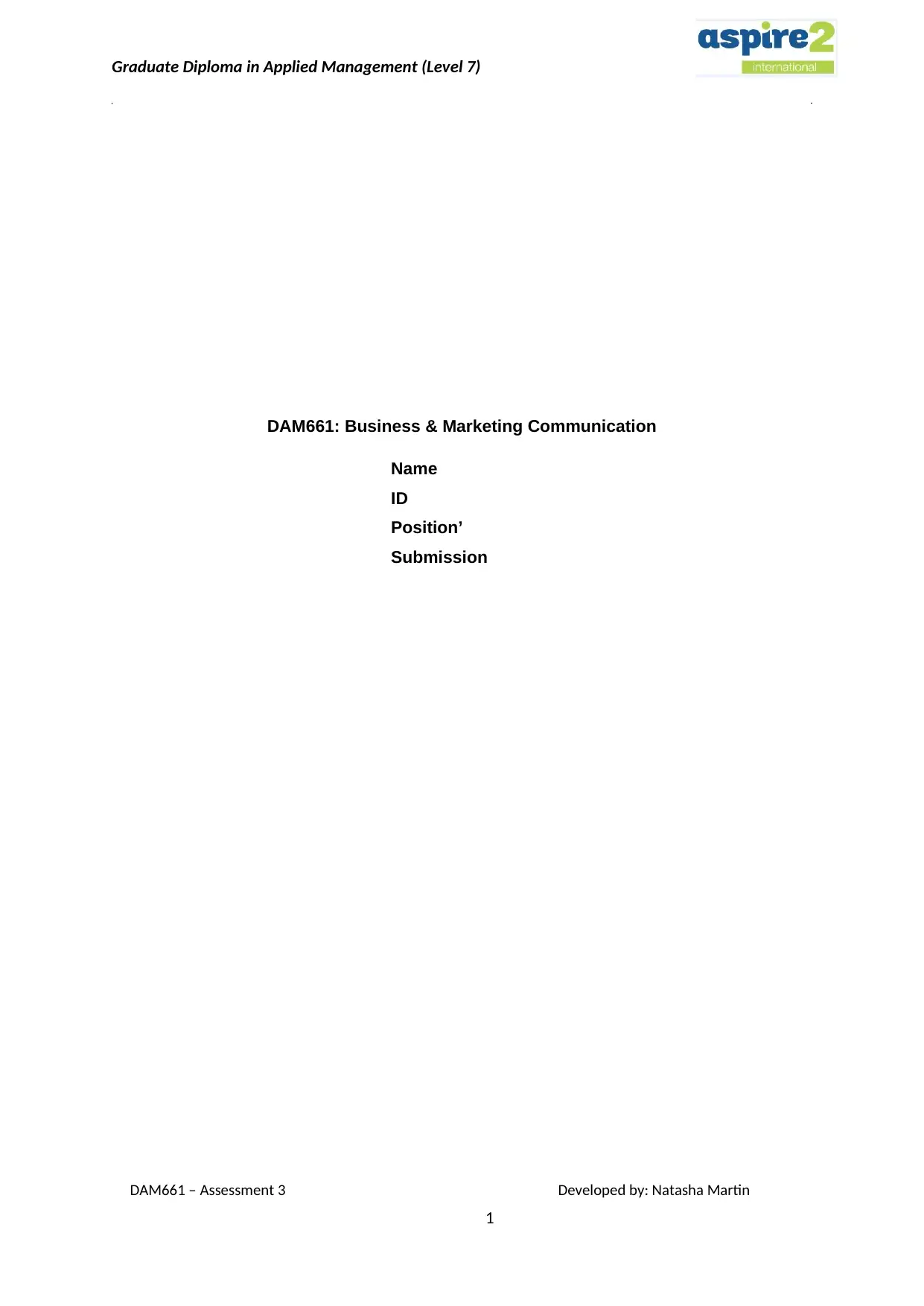
Graduate Diploma in Applied Management (Level 7)
DAM661: Business & Marketing Communication
Name
ID
Position’
Submission
DAM661 – Assessment 3 Developed by: Natasha Martin
1
DAM661: Business & Marketing Communication
Name
ID
Position’
Submission
DAM661 – Assessment 3 Developed by: Natasha Martin
1
Paraphrase This Document
Need a fresh take? Get an instant paraphrase of this document with our AI Paraphraser
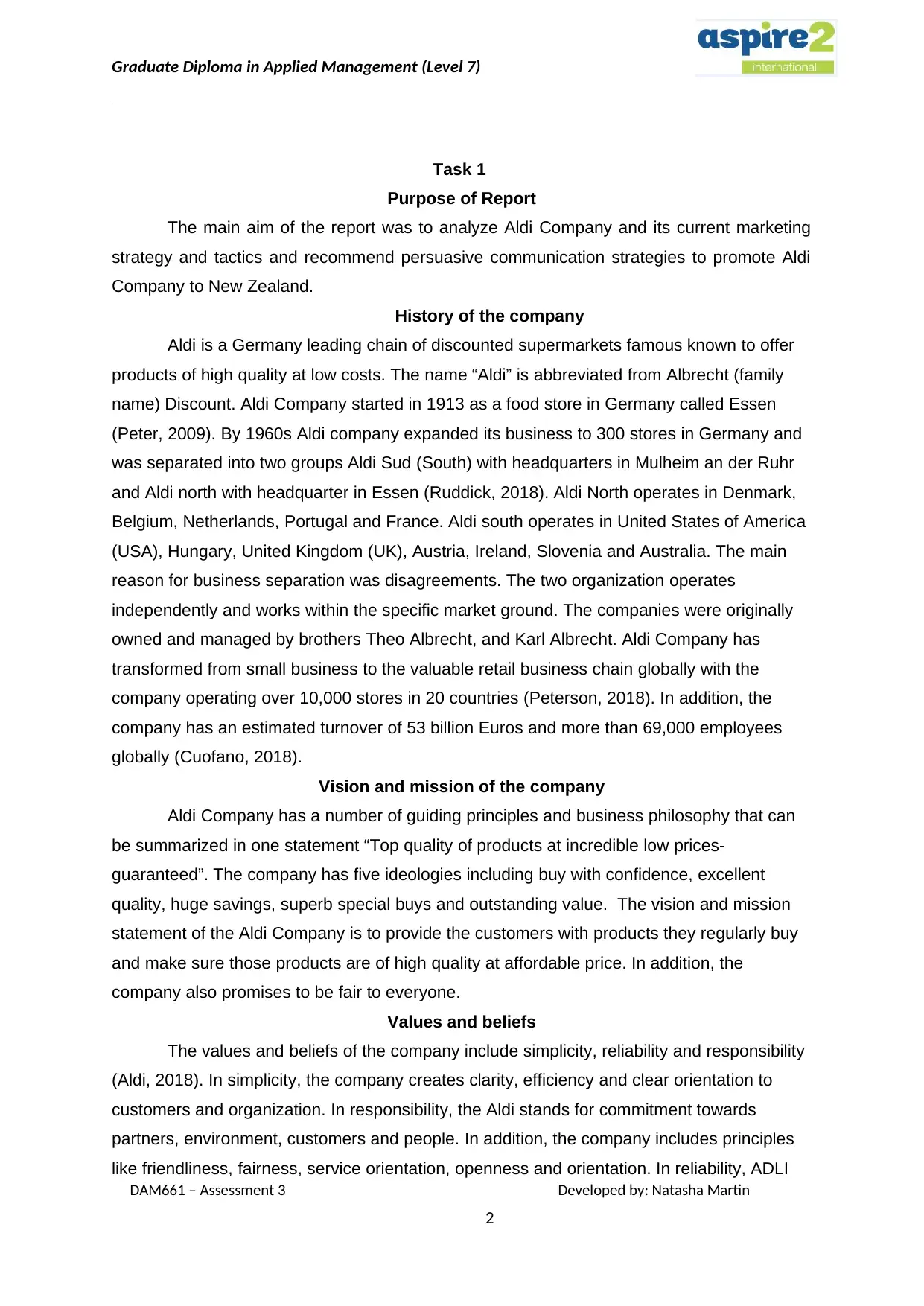
Graduate Diploma in Applied Management (Level 7)
Task 1
Purpose of Report
The main aim of the report was to analyze Aldi Company and its current marketing
strategy and tactics and recommend persuasive communication strategies to promote Aldi
Company to New Zealand.
History of the company
Aldi is a Germany leading chain of discounted supermarkets famous known to offer
products of high quality at low costs. The name “Aldi” is abbreviated from Albrecht (family
name) Discount. Aldi Company started in 1913 as a food store in Germany called Essen
(Peter, 2009). By 1960s Aldi company expanded its business to 300 stores in Germany and
was separated into two groups Aldi Sud (South) with headquarters in Mulheim an der Ruhr
and Aldi north with headquarter in Essen (Ruddick, 2018). Aldi North operates in Denmark,
Belgium, Netherlands, Portugal and France. Aldi south operates in United States of America
(USA), Hungary, United Kingdom (UK), Austria, Ireland, Slovenia and Australia. The main
reason for business separation was disagreements. The two organization operates
independently and works within the specific market ground. The companies were originally
owned and managed by brothers Theo Albrecht, and Karl Albrecht. Aldi Company has
transformed from small business to the valuable retail business chain globally with the
company operating over 10,000 stores in 20 countries (Peterson, 2018). In addition, the
company has an estimated turnover of 53 billion Euros and more than 69,000 employees
globally (Cuofano, 2018).
Vision and mission of the company
Aldi Company has a number of guiding principles and business philosophy that can
be summarized in one statement “Top quality of products at incredible low prices-
guaranteed”. The company has five ideologies including buy with confidence, excellent
quality, huge savings, superb special buys and outstanding value. The vision and mission
statement of the Aldi Company is to provide the customers with products they regularly buy
and make sure those products are of high quality at affordable price. In addition, the
company also promises to be fair to everyone.
Values and beliefs
The values and beliefs of the company include simplicity, reliability and responsibility
(Aldi, 2018). In simplicity, the company creates clarity, efficiency and clear orientation to
customers and organization. In responsibility, the Aldi stands for commitment towards
partners, environment, customers and people. In addition, the company includes principles
like friendliness, fairness, service orientation, openness and orientation. In reliability, ADLI
DAM661 – Assessment 3 Developed by: Natasha Martin
2
Task 1
Purpose of Report
The main aim of the report was to analyze Aldi Company and its current marketing
strategy and tactics and recommend persuasive communication strategies to promote Aldi
Company to New Zealand.
History of the company
Aldi is a Germany leading chain of discounted supermarkets famous known to offer
products of high quality at low costs. The name “Aldi” is abbreviated from Albrecht (family
name) Discount. Aldi Company started in 1913 as a food store in Germany called Essen
(Peter, 2009). By 1960s Aldi company expanded its business to 300 stores in Germany and
was separated into two groups Aldi Sud (South) with headquarters in Mulheim an der Ruhr
and Aldi north with headquarter in Essen (Ruddick, 2018). Aldi North operates in Denmark,
Belgium, Netherlands, Portugal and France. Aldi south operates in United States of America
(USA), Hungary, United Kingdom (UK), Austria, Ireland, Slovenia and Australia. The main
reason for business separation was disagreements. The two organization operates
independently and works within the specific market ground. The companies were originally
owned and managed by brothers Theo Albrecht, and Karl Albrecht. Aldi Company has
transformed from small business to the valuable retail business chain globally with the
company operating over 10,000 stores in 20 countries (Peterson, 2018). In addition, the
company has an estimated turnover of 53 billion Euros and more than 69,000 employees
globally (Cuofano, 2018).
Vision and mission of the company
Aldi Company has a number of guiding principles and business philosophy that can
be summarized in one statement “Top quality of products at incredible low prices-
guaranteed”. The company has five ideologies including buy with confidence, excellent
quality, huge savings, superb special buys and outstanding value. The vision and mission
statement of the Aldi Company is to provide the customers with products they regularly buy
and make sure those products are of high quality at affordable price. In addition, the
company also promises to be fair to everyone.
Values and beliefs
The values and beliefs of the company include simplicity, reliability and responsibility
(Aldi, 2018). In simplicity, the company creates clarity, efficiency and clear orientation to
customers and organization. In responsibility, the Aldi stands for commitment towards
partners, environment, customers and people. In addition, the company includes principles
like friendliness, fairness, service orientation, openness and orientation. In reliability, ADLI
DAM661 – Assessment 3 Developed by: Natasha Martin
2

Company means what it says. The company is consistent with people, price, products and
all other aspects of day-to-day professional life.
Product portfolio offered by ALDI
ALDI offers a range of products lines that meet concerns, needs and dietary
interests. Australia products ranges are limited as Aldi stores offer about 1,000 stock
keeping units (SKU’s) as compared to 30,000 SKU’s for Woolworth’s and Coles (Perrey,
Freundt & Spillecke, 2015). The product categories offered by the compare are restricted in
terms of size on offer and brands. The product range includes simple nature line that
consists of several organic items, never any brand of meat products that consist of animal
byproducts added hormones and antibiotics and LiveGfree line of certified gluten-free
products.
Simple nature product line offers around 200 products every day (Aldi. 2018). The
primary products are organic foods and all items produced according to practices without
genetically modified organisms. Precisely, simple nature product line ranges from pantry
staples such as pasta sauce, fruit bars, cereal and honey, to fresh items like yogurt, salad
mixes, kale, milk and bread. Exclusive line of liveGfree or gluten-free foods includes
granola, brownie mix, pasta, bread, cookies and pretzels.
Never any is a product line of Aldi Company that has no antibiotics, animal
byproducts and added hormones. In addition, never any products are free from added
gluten, preservatives, fillers, casein and nitrates or nitrites. Earth Grown are products made
with ingredients like hearty grains and vegetables. Furthermore, Earth Grown line of
vegetarian products and vegan is for customers looking for plant-based options like tenders,
chickenless patties, kale and quinoa crunch burgers.
Task 2
Competitor Strengths Weaknesses Product
features or
benefit
Promotion strategy
Pak n Save -Market leading position in
New Zealand
-good reputation because of
community programs
-Self-checkouts register
which helps people save
time instead of waiting on
line
- the company offers
multiple products
-limited product
selection
-uncertainty in cost
structure
- higher prices
-stores famous in
certain locality
hence less market
share
Fresh food and
great quality
vegetables,
fruit, bakery
items, seafood,
meat at low
prices.
-Sales promotions
-Advertisements on
billboards, televisions,
newspapers and radio
stations.
advertisement through
pamphlets
all other aspects of day-to-day professional life.
Product portfolio offered by ALDI
ALDI offers a range of products lines that meet concerns, needs and dietary
interests. Australia products ranges are limited as Aldi stores offer about 1,000 stock
keeping units (SKU’s) as compared to 30,000 SKU’s for Woolworth’s and Coles (Perrey,
Freundt & Spillecke, 2015). The product categories offered by the compare are restricted in
terms of size on offer and brands. The product range includes simple nature line that
consists of several organic items, never any brand of meat products that consist of animal
byproducts added hormones and antibiotics and LiveGfree line of certified gluten-free
products.
Simple nature product line offers around 200 products every day (Aldi. 2018). The
primary products are organic foods and all items produced according to practices without
genetically modified organisms. Precisely, simple nature product line ranges from pantry
staples such as pasta sauce, fruit bars, cereal and honey, to fresh items like yogurt, salad
mixes, kale, milk and bread. Exclusive line of liveGfree or gluten-free foods includes
granola, brownie mix, pasta, bread, cookies and pretzels.
Never any is a product line of Aldi Company that has no antibiotics, animal
byproducts and added hormones. In addition, never any products are free from added
gluten, preservatives, fillers, casein and nitrates or nitrites. Earth Grown are products made
with ingredients like hearty grains and vegetables. Furthermore, Earth Grown line of
vegetarian products and vegan is for customers looking for plant-based options like tenders,
chickenless patties, kale and quinoa crunch burgers.
Task 2
Competitor Strengths Weaknesses Product
features or
benefit
Promotion strategy
Pak n Save -Market leading position in
New Zealand
-good reputation because of
community programs
-Self-checkouts register
which helps people save
time instead of waiting on
line
- the company offers
multiple products
-limited product
selection
-uncertainty in cost
structure
- higher prices
-stores famous in
certain locality
hence less market
share
Fresh food and
great quality
vegetables,
fruit, bakery
items, seafood,
meat at low
prices.
-Sales promotions
-Advertisements on
billboards, televisions,
newspapers and radio
stations.
advertisement through
pamphlets
⊘ This is a preview!⊘
Do you want full access?
Subscribe today to unlock all pages.

Trusted by 1+ million students worldwide
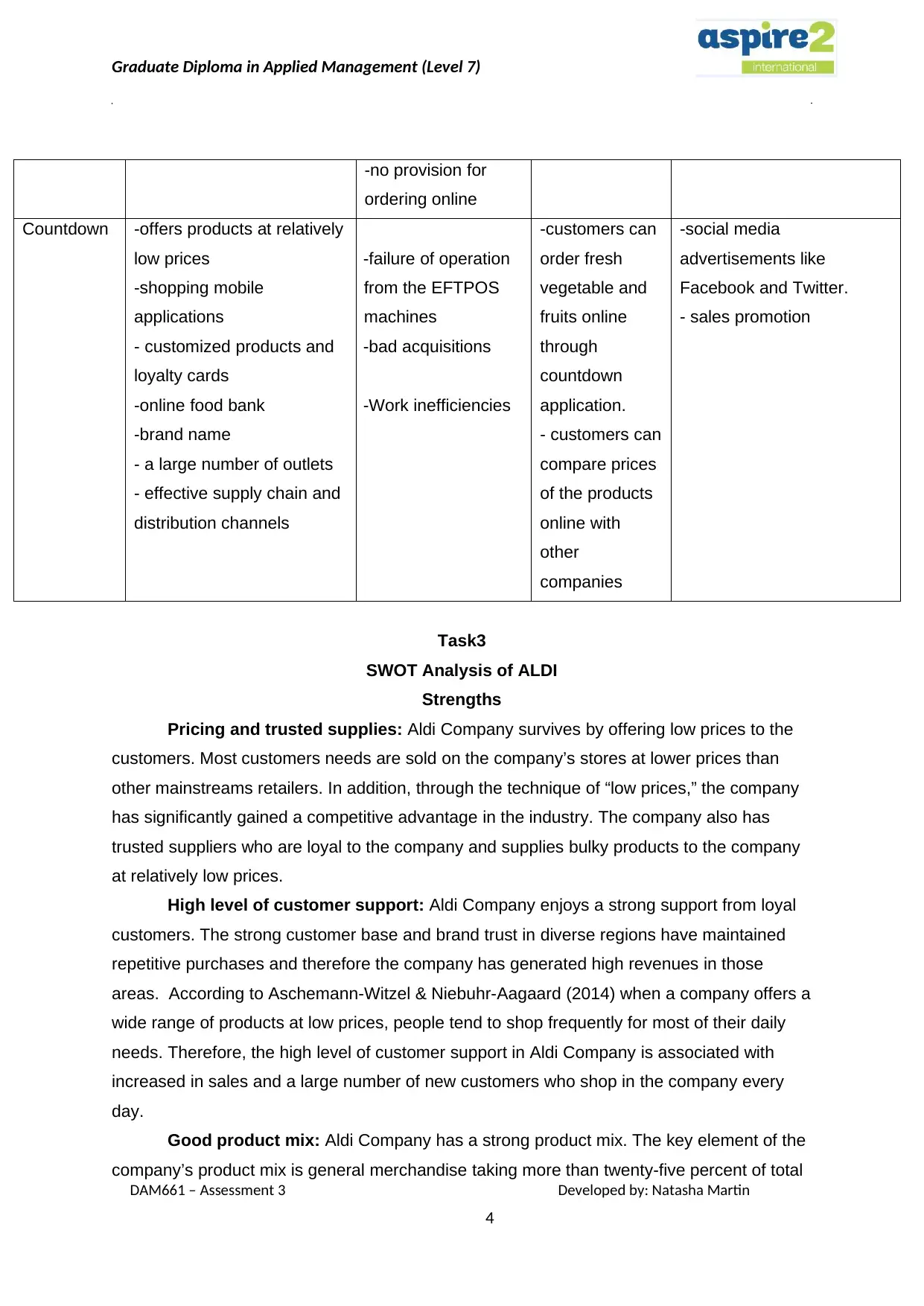
Graduate Diploma in Applied Management (Level 7)
-no provision for
ordering online
Countdown -offers products at relatively
low prices
-shopping mobile
applications
- customized products and
loyalty cards
-online food bank
-brand name
- a large number of outlets
- effective supply chain and
distribution channels
-failure of operation
from the EFTPOS
machines
-bad acquisitions
-Work inefficiencies
-customers can
order fresh
vegetable and
fruits online
through
countdown
application.
- customers can
compare prices
of the products
online with
other
companies
-social media
advertisements like
Facebook and Twitter.
- sales promotion
Task3
SWOT Analysis of ALDI
Strengths
Pricing and trusted supplies: Aldi Company survives by offering low prices to the
customers. Most customers needs are sold on the company’s stores at lower prices than
other mainstreams retailers. In addition, through the technique of “low prices,” the company
has significantly gained a competitive advantage in the industry. The company also has
trusted suppliers who are loyal to the company and supplies bulky products to the company
at relatively low prices.
High level of customer support: Aldi Company enjoys a strong support from loyal
customers. The strong customer base and brand trust in diverse regions have maintained
repetitive purchases and therefore the company has generated high revenues in those
areas. According to Aschemann-Witzel & Niebuhr-Aagaard (2014) when a company offers a
wide range of products at low prices, people tend to shop frequently for most of their daily
needs. Therefore, the high level of customer support in Aldi Company is associated with
increased in sales and a large number of new customers who shop in the company every
day.
Good product mix: Aldi Company has a strong product mix. The key element of the
company’s product mix is general merchandise taking more than twenty-five percent of total
DAM661 – Assessment 3 Developed by: Natasha Martin
4
-no provision for
ordering online
Countdown -offers products at relatively
low prices
-shopping mobile
applications
- customized products and
loyalty cards
-online food bank
-brand name
- a large number of outlets
- effective supply chain and
distribution channels
-failure of operation
from the EFTPOS
machines
-bad acquisitions
-Work inefficiencies
-customers can
order fresh
vegetable and
fruits online
through
countdown
application.
- customers can
compare prices
of the products
online with
other
companies
-social media
advertisements like
Facebook and Twitter.
- sales promotion
Task3
SWOT Analysis of ALDI
Strengths
Pricing and trusted supplies: Aldi Company survives by offering low prices to the
customers. Most customers needs are sold on the company’s stores at lower prices than
other mainstreams retailers. In addition, through the technique of “low prices,” the company
has significantly gained a competitive advantage in the industry. The company also has
trusted suppliers who are loyal to the company and supplies bulky products to the company
at relatively low prices.
High level of customer support: Aldi Company enjoys a strong support from loyal
customers. The strong customer base and brand trust in diverse regions have maintained
repetitive purchases and therefore the company has generated high revenues in those
areas. According to Aschemann-Witzel & Niebuhr-Aagaard (2014) when a company offers a
wide range of products at low prices, people tend to shop frequently for most of their daily
needs. Therefore, the high level of customer support in Aldi Company is associated with
increased in sales and a large number of new customers who shop in the company every
day.
Good product mix: Aldi Company has a strong product mix. The key element of the
company’s product mix is general merchandise taking more than twenty-five percent of total
DAM661 – Assessment 3 Developed by: Natasha Martin
4
Paraphrase This Document
Need a fresh take? Get an instant paraphrase of this document with our AI Paraphraser
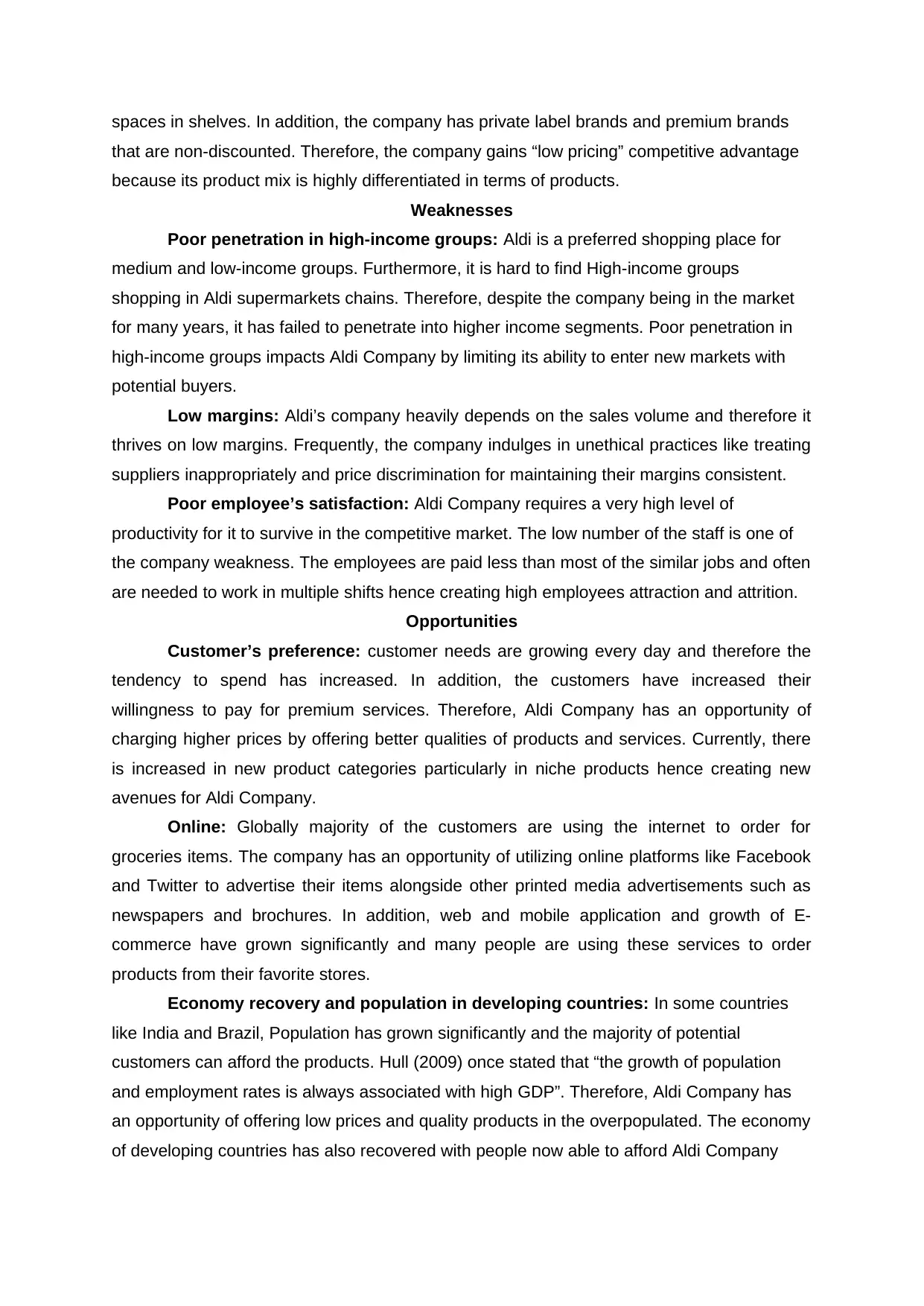
spaces in shelves. In addition, the company has private label brands and premium brands
that are non-discounted. Therefore, the company gains “low pricing” competitive advantage
because its product mix is highly differentiated in terms of products.
Weaknesses
Poor penetration in high-income groups: Aldi is a preferred shopping place for
medium and low-income groups. Furthermore, it is hard to find High-income groups
shopping in Aldi supermarkets chains. Therefore, despite the company being in the market
for many years, it has failed to penetrate into higher income segments. Poor penetration in
high-income groups impacts Aldi Company by limiting its ability to enter new markets with
potential buyers.
Low margins: Aldi’s company heavily depends on the sales volume and therefore it
thrives on low margins. Frequently, the company indulges in unethical practices like treating
suppliers inappropriately and price discrimination for maintaining their margins consistent.
Poor employee’s satisfaction: Aldi Company requires a very high level of
productivity for it to survive in the competitive market. The low number of the staff is one of
the company weakness. The employees are paid less than most of the similar jobs and often
are needed to work in multiple shifts hence creating high employees attraction and attrition.
Opportunities
Customer’s preference: customer needs are growing every day and therefore the
tendency to spend has increased. In addition, the customers have increased their
willingness to pay for premium services. Therefore, Aldi Company has an opportunity of
charging higher prices by offering better qualities of products and services. Currently, there
is increased in new product categories particularly in niche products hence creating new
avenues for Aldi Company.
Online: Globally majority of the customers are using the internet to order for
groceries items. The company has an opportunity of utilizing online platforms like Facebook
and Twitter to advertise their items alongside other printed media advertisements such as
newspapers and brochures. In addition, web and mobile application and growth of E-
commerce have grown significantly and many people are using these services to order
products from their favorite stores.
Economy recovery and population in developing countries: In some countries
like India and Brazil, Population has grown significantly and the majority of potential
customers can afford the products. Hull (2009) once stated that “the growth of population
and employment rates is always associated with high GDP”. Therefore, Aldi Company has
an opportunity of offering low prices and quality products in the overpopulated. The economy
of developing countries has also recovered with people now able to afford Aldi Company
that are non-discounted. Therefore, the company gains “low pricing” competitive advantage
because its product mix is highly differentiated in terms of products.
Weaknesses
Poor penetration in high-income groups: Aldi is a preferred shopping place for
medium and low-income groups. Furthermore, it is hard to find High-income groups
shopping in Aldi supermarkets chains. Therefore, despite the company being in the market
for many years, it has failed to penetrate into higher income segments. Poor penetration in
high-income groups impacts Aldi Company by limiting its ability to enter new markets with
potential buyers.
Low margins: Aldi’s company heavily depends on the sales volume and therefore it
thrives on low margins. Frequently, the company indulges in unethical practices like treating
suppliers inappropriately and price discrimination for maintaining their margins consistent.
Poor employee’s satisfaction: Aldi Company requires a very high level of
productivity for it to survive in the competitive market. The low number of the staff is one of
the company weakness. The employees are paid less than most of the similar jobs and often
are needed to work in multiple shifts hence creating high employees attraction and attrition.
Opportunities
Customer’s preference: customer needs are growing every day and therefore the
tendency to spend has increased. In addition, the customers have increased their
willingness to pay for premium services. Therefore, Aldi Company has an opportunity of
charging higher prices by offering better qualities of products and services. Currently, there
is increased in new product categories particularly in niche products hence creating new
avenues for Aldi Company.
Online: Globally majority of the customers are using the internet to order for
groceries items. The company has an opportunity of utilizing online platforms like Facebook
and Twitter to advertise their items alongside other printed media advertisements such as
newspapers and brochures. In addition, web and mobile application and growth of E-
commerce have grown significantly and many people are using these services to order
products from their favorite stores.
Economy recovery and population in developing countries: In some countries
like India and Brazil, Population has grown significantly and the majority of potential
customers can afford the products. Hull (2009) once stated that “the growth of population
and employment rates is always associated with high GDP”. Therefore, Aldi Company has
an opportunity of offering low prices and quality products in the overpopulated. The economy
of developing countries has also recovered with people now able to afford Aldi Company
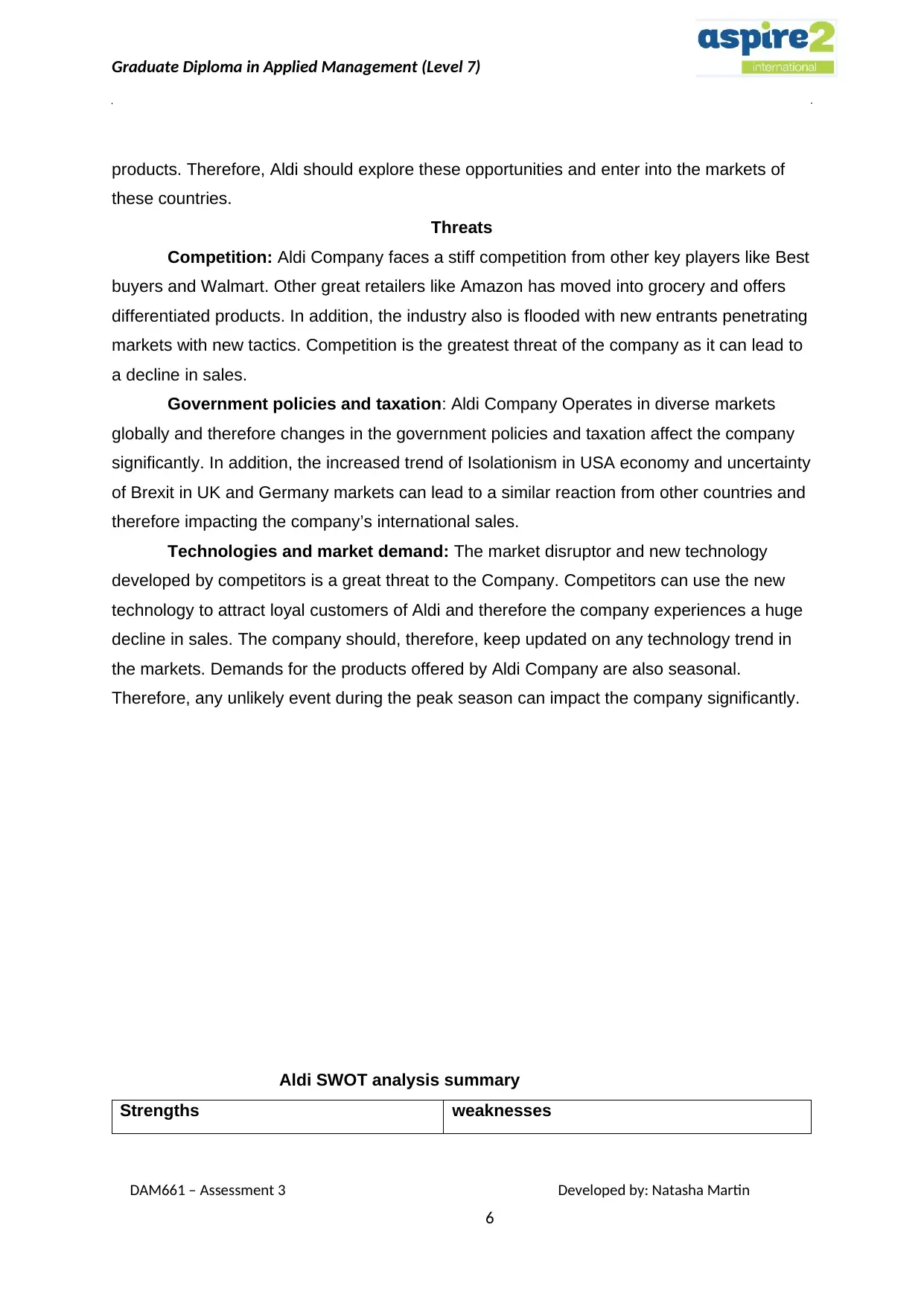
Graduate Diploma in Applied Management (Level 7)
products. Therefore, Aldi should explore these opportunities and enter into the markets of
these countries.
Threats
Competition: Aldi Company faces a stiff competition from other key players like Best
buyers and Walmart. Other great retailers like Amazon has moved into grocery and offers
differentiated products. In addition, the industry also is flooded with new entrants penetrating
markets with new tactics. Competition is the greatest threat of the company as it can lead to
a decline in sales.
Government policies and taxation: Aldi Company Operates in diverse markets
globally and therefore changes in the government policies and taxation affect the company
significantly. In addition, the increased trend of Isolationism in USA economy and uncertainty
of Brexit in UK and Germany markets can lead to a similar reaction from other countries and
therefore impacting the company’s international sales.
Technologies and market demand: The market disruptor and new technology
developed by competitors is a great threat to the Company. Competitors can use the new
technology to attract loyal customers of Aldi and therefore the company experiences a huge
decline in sales. The company should, therefore, keep updated on any technology trend in
the markets. Demands for the products offered by Aldi Company are also seasonal.
Therefore, any unlikely event during the peak season can impact the company significantly.
Aldi SWOT analysis summary
Strengths weaknesses
DAM661 – Assessment 3 Developed by: Natasha Martin
6
products. Therefore, Aldi should explore these opportunities and enter into the markets of
these countries.
Threats
Competition: Aldi Company faces a stiff competition from other key players like Best
buyers and Walmart. Other great retailers like Amazon has moved into grocery and offers
differentiated products. In addition, the industry also is flooded with new entrants penetrating
markets with new tactics. Competition is the greatest threat of the company as it can lead to
a decline in sales.
Government policies and taxation: Aldi Company Operates in diverse markets
globally and therefore changes in the government policies and taxation affect the company
significantly. In addition, the increased trend of Isolationism in USA economy and uncertainty
of Brexit in UK and Germany markets can lead to a similar reaction from other countries and
therefore impacting the company’s international sales.
Technologies and market demand: The market disruptor and new technology
developed by competitors is a great threat to the Company. Competitors can use the new
technology to attract loyal customers of Aldi and therefore the company experiences a huge
decline in sales. The company should, therefore, keep updated on any technology trend in
the markets. Demands for the products offered by Aldi Company are also seasonal.
Therefore, any unlikely event during the peak season can impact the company significantly.
Aldi SWOT analysis summary
Strengths weaknesses
DAM661 – Assessment 3 Developed by: Natasha Martin
6
⊘ This is a preview!⊘
Do you want full access?
Subscribe today to unlock all pages.

Trusted by 1+ million students worldwide
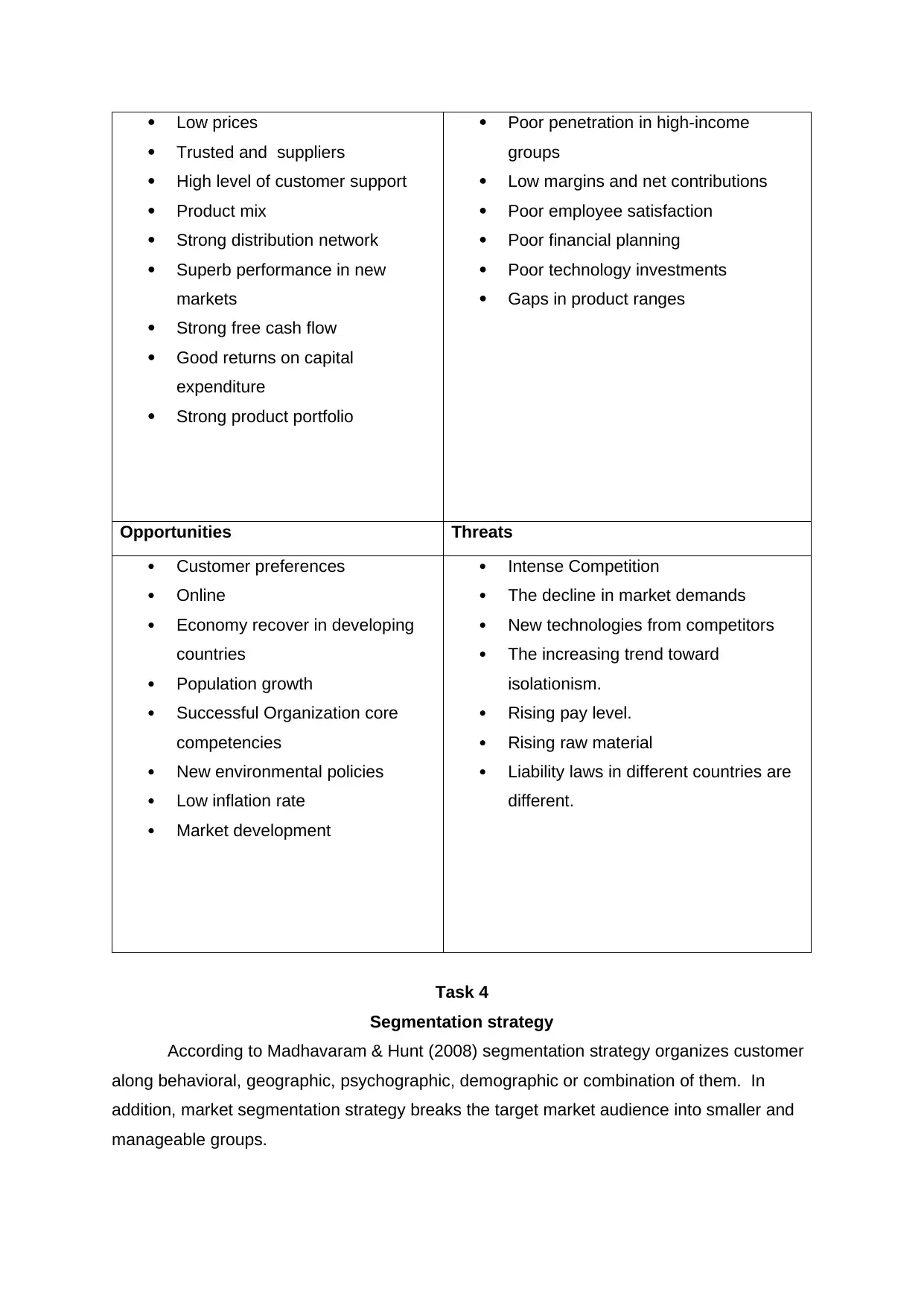
Low prices
Trusted and suppliers
High level of customer support
Product mix
Strong distribution network
Superb performance in new
markets
Strong free cash flow
Good returns on capital
expenditure
Strong product portfolio
Poor penetration in high-income
groups
Low margins and net contributions
Poor employee satisfaction
Poor financial planning
Poor technology investments
Gaps in product ranges
Opportunities Threats
Customer preferences
Online
Economy recover in developing
countries
Population growth
Successful Organization core
competencies
New environmental policies
Low inflation rate
Market development
Intense Competition
The decline in market demands
New technologies from competitors
The increasing trend toward
isolationism.
Rising pay level.
Rising raw material
Liability laws in different countries are
different.
Task 4
Segmentation strategy
According to Madhavaram & Hunt (2008) segmentation strategy organizes customer
along behavioral, geographic, psychographic, demographic or combination of them. In
addition, market segmentation strategy breaks the target market audience into smaller and
manageable groups.
Trusted and suppliers
High level of customer support
Product mix
Strong distribution network
Superb performance in new
markets
Strong free cash flow
Good returns on capital
expenditure
Strong product portfolio
Poor penetration in high-income
groups
Low margins and net contributions
Poor employee satisfaction
Poor financial planning
Poor technology investments
Gaps in product ranges
Opportunities Threats
Customer preferences
Online
Economy recover in developing
countries
Population growth
Successful Organization core
competencies
New environmental policies
Low inflation rate
Market development
Intense Competition
The decline in market demands
New technologies from competitors
The increasing trend toward
isolationism.
Rising pay level.
Rising raw material
Liability laws in different countries are
different.
Task 4
Segmentation strategy
According to Madhavaram & Hunt (2008) segmentation strategy organizes customer
along behavioral, geographic, psychographic, demographic or combination of them. In
addition, market segmentation strategy breaks the target market audience into smaller and
manageable groups.
Paraphrase This Document
Need a fresh take? Get an instant paraphrase of this document with our AI Paraphraser
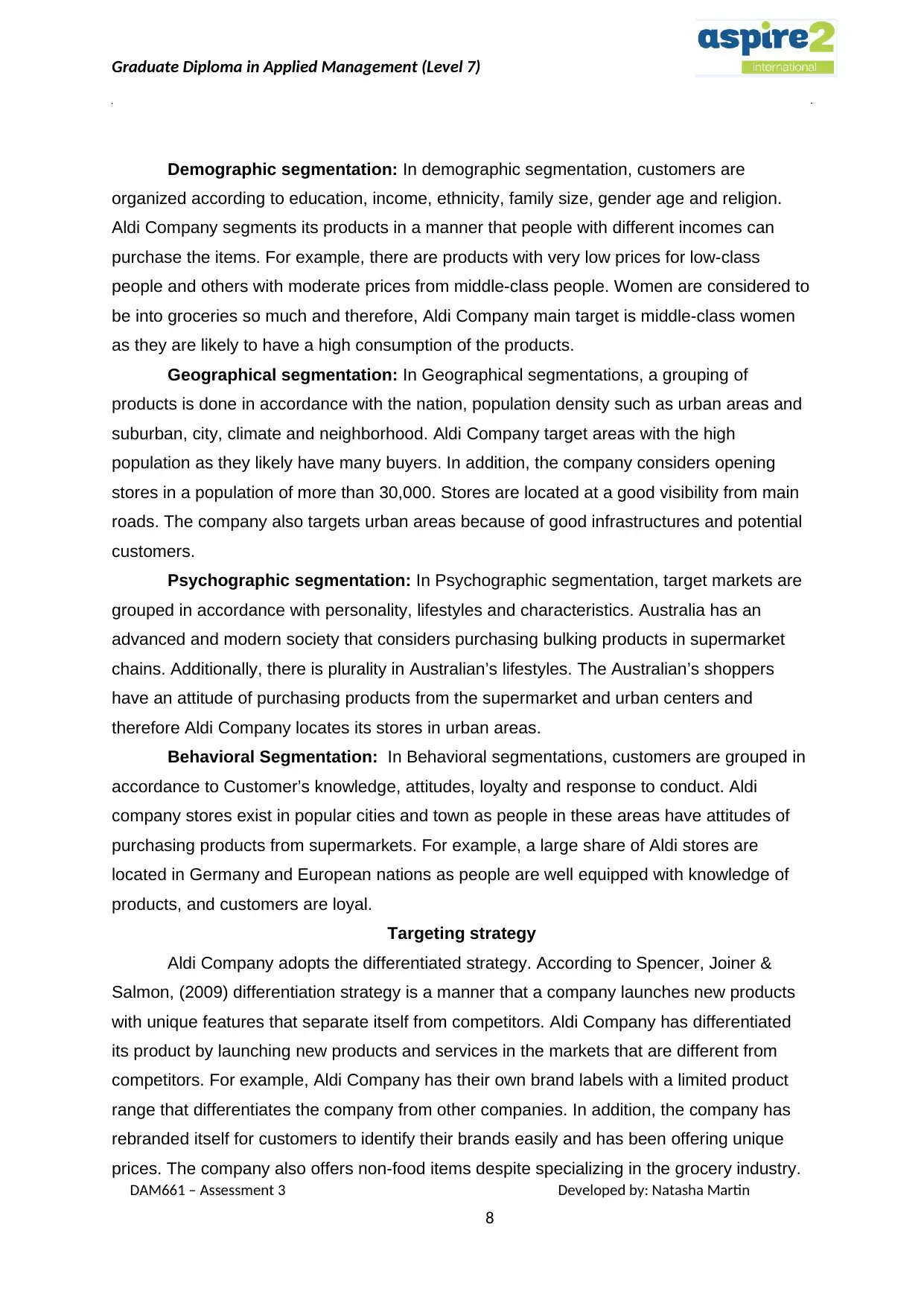
Graduate Diploma in Applied Management (Level 7)
Demographic segmentation: In demographic segmentation, customers are
organized according to education, income, ethnicity, family size, gender age and religion.
Aldi Company segments its products in a manner that people with different incomes can
purchase the items. For example, there are products with very low prices for low-class
people and others with moderate prices from middle-class people. Women are considered to
be into groceries so much and therefore, Aldi Company main target is middle-class women
as they are likely to have a high consumption of the products.
Geographical segmentation: In Geographical segmentations, a grouping of
products is done in accordance with the nation, population density such as urban areas and
suburban, city, climate and neighborhood. Aldi Company target areas with the high
population as they likely have many buyers. In addition, the company considers opening
stores in a population of more than 30,000. Stores are located at a good visibility from main
roads. The company also targets urban areas because of good infrastructures and potential
customers.
Psychographic segmentation: In Psychographic segmentation, target markets are
grouped in accordance with personality, lifestyles and characteristics. Australia has an
advanced and modern society that considers purchasing bulking products in supermarket
chains. Additionally, there is plurality in Australian’s lifestyles. The Australian’s shoppers
have an attitude of purchasing products from the supermarket and urban centers and
therefore Aldi Company locates its stores in urban areas.
Behavioral Segmentation: In Behavioral segmentations, customers are grouped in
accordance to Customer’s knowledge, attitudes, loyalty and response to conduct. Aldi
company stores exist in popular cities and town as people in these areas have attitudes of
purchasing products from supermarkets. For example, a large share of Aldi stores are
located in Germany and European nations as people are well equipped with knowledge of
products, and customers are loyal.
Targeting strategy
Aldi Company adopts the differentiated strategy. According to Spencer, Joiner &
Salmon, (2009) differentiation strategy is a manner that a company launches new products
with unique features that separate itself from competitors. Aldi Company has differentiated
its product by launching new products and services in the markets that are different from
competitors. For example, Aldi Company has their own brand labels with a limited product
range that differentiates the company from other companies. In addition, the company has
rebranded itself for customers to identify their brands easily and has been offering unique
prices. The company also offers non-food items despite specializing in the grocery industry.
DAM661 – Assessment 3 Developed by: Natasha Martin
8
Demographic segmentation: In demographic segmentation, customers are
organized according to education, income, ethnicity, family size, gender age and religion.
Aldi Company segments its products in a manner that people with different incomes can
purchase the items. For example, there are products with very low prices for low-class
people and others with moderate prices from middle-class people. Women are considered to
be into groceries so much and therefore, Aldi Company main target is middle-class women
as they are likely to have a high consumption of the products.
Geographical segmentation: In Geographical segmentations, a grouping of
products is done in accordance with the nation, population density such as urban areas and
suburban, city, climate and neighborhood. Aldi Company target areas with the high
population as they likely have many buyers. In addition, the company considers opening
stores in a population of more than 30,000. Stores are located at a good visibility from main
roads. The company also targets urban areas because of good infrastructures and potential
customers.
Psychographic segmentation: In Psychographic segmentation, target markets are
grouped in accordance with personality, lifestyles and characteristics. Australia has an
advanced and modern society that considers purchasing bulking products in supermarket
chains. Additionally, there is plurality in Australian’s lifestyles. The Australian’s shoppers
have an attitude of purchasing products from the supermarket and urban centers and
therefore Aldi Company locates its stores in urban areas.
Behavioral Segmentation: In Behavioral segmentations, customers are grouped in
accordance to Customer’s knowledge, attitudes, loyalty and response to conduct. Aldi
company stores exist in popular cities and town as people in these areas have attitudes of
purchasing products from supermarkets. For example, a large share of Aldi stores are
located in Germany and European nations as people are well equipped with knowledge of
products, and customers are loyal.
Targeting strategy
Aldi Company adopts the differentiated strategy. According to Spencer, Joiner &
Salmon, (2009) differentiation strategy is a manner that a company launches new products
with unique features that separate itself from competitors. Aldi Company has differentiated
its product by launching new products and services in the markets that are different from
competitors. For example, Aldi Company has their own brand labels with a limited product
range that differentiates the company from other companies. In addition, the company has
rebranded itself for customers to identify their brands easily and has been offering unique
prices. The company also offers non-food items despite specializing in the grocery industry.
DAM661 – Assessment 3 Developed by: Natasha Martin
8
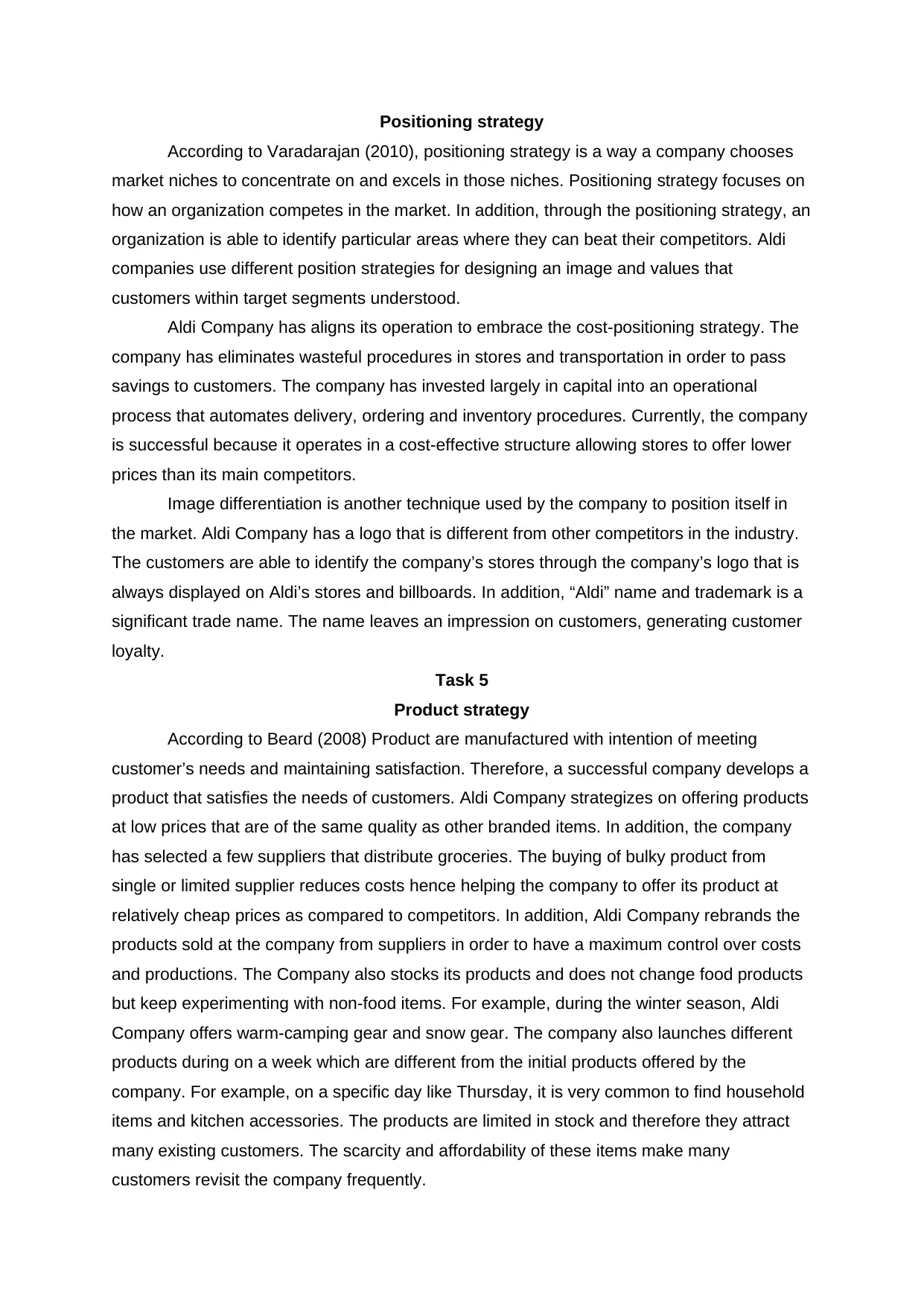
Positioning strategy
According to Varadarajan (2010), positioning strategy is a way a company chooses
market niches to concentrate on and excels in those niches. Positioning strategy focuses on
how an organization competes in the market. In addition, through the positioning strategy, an
organization is able to identify particular areas where they can beat their competitors. Aldi
companies use different position strategies for designing an image and values that
customers within target segments understood.
Aldi Company has aligns its operation to embrace the cost-positioning strategy. The
company has eliminates wasteful procedures in stores and transportation in order to pass
savings to customers. The company has invested largely in capital into an operational
process that automates delivery, ordering and inventory procedures. Currently, the company
is successful because it operates in a cost-effective structure allowing stores to offer lower
prices than its main competitors.
Image differentiation is another technique used by the company to position itself in
the market. Aldi Company has a logo that is different from other competitors in the industry.
The customers are able to identify the company’s stores through the company’s logo that is
always displayed on Aldi’s stores and billboards. In addition, “Aldi” name and trademark is a
significant trade name. The name leaves an impression on customers, generating customer
loyalty.
Task 5
Product strategy
According to Beard (2008) Product are manufactured with intention of meeting
customer’s needs and maintaining satisfaction. Therefore, a successful company develops a
product that satisfies the needs of customers. Aldi Company strategizes on offering products
at low prices that are of the same quality as other branded items. In addition, the company
has selected a few suppliers that distribute groceries. The buying of bulky product from
single or limited supplier reduces costs hence helping the company to offer its product at
relatively cheap prices as compared to competitors. In addition, Aldi Company rebrands the
products sold at the company from suppliers in order to have a maximum control over costs
and productions. The Company also stocks its products and does not change food products
but keep experimenting with non-food items. For example, during the winter season, Aldi
Company offers warm-camping gear and snow gear. The company also launches different
products during on a week which are different from the initial products offered by the
company. For example, on a specific day like Thursday, it is very common to find household
items and kitchen accessories. The products are limited in stock and therefore they attract
many existing customers. The scarcity and affordability of these items make many
customers revisit the company frequently.
According to Varadarajan (2010), positioning strategy is a way a company chooses
market niches to concentrate on and excels in those niches. Positioning strategy focuses on
how an organization competes in the market. In addition, through the positioning strategy, an
organization is able to identify particular areas where they can beat their competitors. Aldi
companies use different position strategies for designing an image and values that
customers within target segments understood.
Aldi Company has aligns its operation to embrace the cost-positioning strategy. The
company has eliminates wasteful procedures in stores and transportation in order to pass
savings to customers. The company has invested largely in capital into an operational
process that automates delivery, ordering and inventory procedures. Currently, the company
is successful because it operates in a cost-effective structure allowing stores to offer lower
prices than its main competitors.
Image differentiation is another technique used by the company to position itself in
the market. Aldi Company has a logo that is different from other competitors in the industry.
The customers are able to identify the company’s stores through the company’s logo that is
always displayed on Aldi’s stores and billboards. In addition, “Aldi” name and trademark is a
significant trade name. The name leaves an impression on customers, generating customer
loyalty.
Task 5
Product strategy
According to Beard (2008) Product are manufactured with intention of meeting
customer’s needs and maintaining satisfaction. Therefore, a successful company develops a
product that satisfies the needs of customers. Aldi Company strategizes on offering products
at low prices that are of the same quality as other branded items. In addition, the company
has selected a few suppliers that distribute groceries. The buying of bulky product from
single or limited supplier reduces costs hence helping the company to offer its product at
relatively cheap prices as compared to competitors. In addition, Aldi Company rebrands the
products sold at the company from suppliers in order to have a maximum control over costs
and productions. The Company also stocks its products and does not change food products
but keep experimenting with non-food items. For example, during the winter season, Aldi
Company offers warm-camping gear and snow gear. The company also launches different
products during on a week which are different from the initial products offered by the
company. For example, on a specific day like Thursday, it is very common to find household
items and kitchen accessories. The products are limited in stock and therefore they attract
many existing customers. The scarcity and affordability of these items make many
customers revisit the company frequently.
⊘ This is a preview!⊘
Do you want full access?
Subscribe today to unlock all pages.

Trusted by 1+ million students worldwide
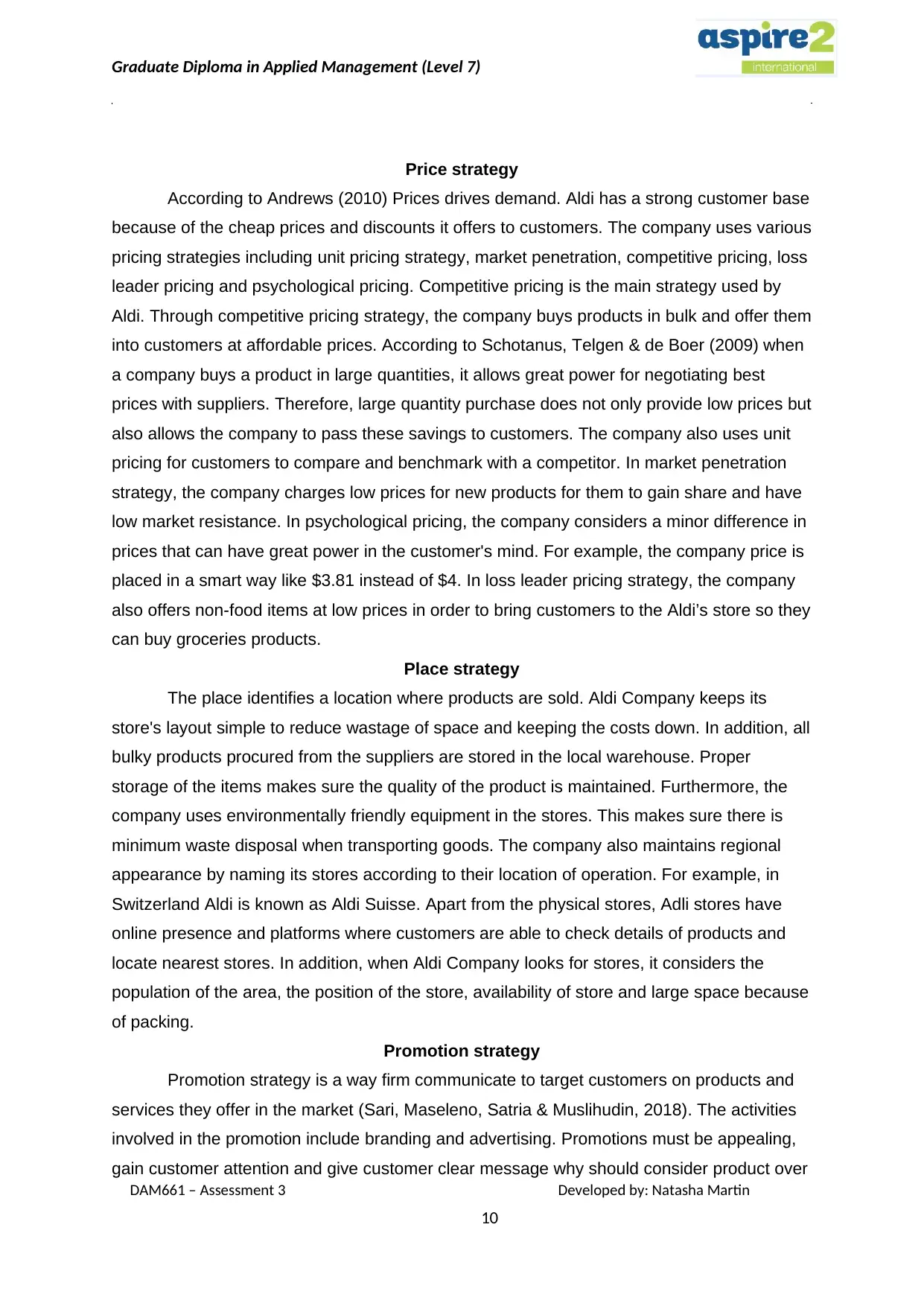
Graduate Diploma in Applied Management (Level 7)
Price strategy
According to Andrews (2010) Prices drives demand. Aldi has a strong customer base
because of the cheap prices and discounts it offers to customers. The company uses various
pricing strategies including unit pricing strategy, market penetration, competitive pricing, loss
leader pricing and psychological pricing. Competitive pricing is the main strategy used by
Aldi. Through competitive pricing strategy, the company buys products in bulk and offer them
into customers at affordable prices. According to Schotanus, Telgen & de Boer (2009) when
a company buys a product in large quantities, it allows great power for negotiating best
prices with suppliers. Therefore, large quantity purchase does not only provide low prices but
also allows the company to pass these savings to customers. The company also uses unit
pricing for customers to compare and benchmark with a competitor. In market penetration
strategy, the company charges low prices for new products for them to gain share and have
low market resistance. In psychological pricing, the company considers a minor difference in
prices that can have great power in the customer's mind. For example, the company price is
placed in a smart way like $3.81 instead of $4. In loss leader pricing strategy, the company
also offers non-food items at low prices in order to bring customers to the Aldi’s store so they
can buy groceries products.
Place strategy
The place identifies a location where products are sold. Aldi Company keeps its
store's layout simple to reduce wastage of space and keeping the costs down. In addition, all
bulky products procured from the suppliers are stored in the local warehouse. Proper
storage of the items makes sure the quality of the product is maintained. Furthermore, the
company uses environmentally friendly equipment in the stores. This makes sure there is
minimum waste disposal when transporting goods. The company also maintains regional
appearance by naming its stores according to their location of operation. For example, in
Switzerland Aldi is known as Aldi Suisse. Apart from the physical stores, Adli stores have
online presence and platforms where customers are able to check details of products and
locate nearest stores. In addition, when Aldi Company looks for stores, it considers the
population of the area, the position of the store, availability of store and large space because
of packing.
Promotion strategy
Promotion strategy is a way firm communicate to target customers on products and
services they offer in the market (Sari, Maseleno, Satria & Muslihudin, 2018). The activities
involved in the promotion include branding and advertising. Promotions must be appealing,
gain customer attention and give customer clear message why should consider product over
DAM661 – Assessment 3 Developed by: Natasha Martin
10
Price strategy
According to Andrews (2010) Prices drives demand. Aldi has a strong customer base
because of the cheap prices and discounts it offers to customers. The company uses various
pricing strategies including unit pricing strategy, market penetration, competitive pricing, loss
leader pricing and psychological pricing. Competitive pricing is the main strategy used by
Aldi. Through competitive pricing strategy, the company buys products in bulk and offer them
into customers at affordable prices. According to Schotanus, Telgen & de Boer (2009) when
a company buys a product in large quantities, it allows great power for negotiating best
prices with suppliers. Therefore, large quantity purchase does not only provide low prices but
also allows the company to pass these savings to customers. The company also uses unit
pricing for customers to compare and benchmark with a competitor. In market penetration
strategy, the company charges low prices for new products for them to gain share and have
low market resistance. In psychological pricing, the company considers a minor difference in
prices that can have great power in the customer's mind. For example, the company price is
placed in a smart way like $3.81 instead of $4. In loss leader pricing strategy, the company
also offers non-food items at low prices in order to bring customers to the Aldi’s store so they
can buy groceries products.
Place strategy
The place identifies a location where products are sold. Aldi Company keeps its
store's layout simple to reduce wastage of space and keeping the costs down. In addition, all
bulky products procured from the suppliers are stored in the local warehouse. Proper
storage of the items makes sure the quality of the product is maintained. Furthermore, the
company uses environmentally friendly equipment in the stores. This makes sure there is
minimum waste disposal when transporting goods. The company also maintains regional
appearance by naming its stores according to their location of operation. For example, in
Switzerland Aldi is known as Aldi Suisse. Apart from the physical stores, Adli stores have
online presence and platforms where customers are able to check details of products and
locate nearest stores. In addition, when Aldi Company looks for stores, it considers the
population of the area, the position of the store, availability of store and large space because
of packing.
Promotion strategy
Promotion strategy is a way firm communicate to target customers on products and
services they offer in the market (Sari, Maseleno, Satria & Muslihudin, 2018). The activities
involved in the promotion include branding and advertising. Promotions must be appealing,
gain customer attention and give customer clear message why should consider product over
DAM661 – Assessment 3 Developed by: Natasha Martin
10
Paraphrase This Document
Need a fresh take? Get an instant paraphrase of this document with our AI Paraphraser
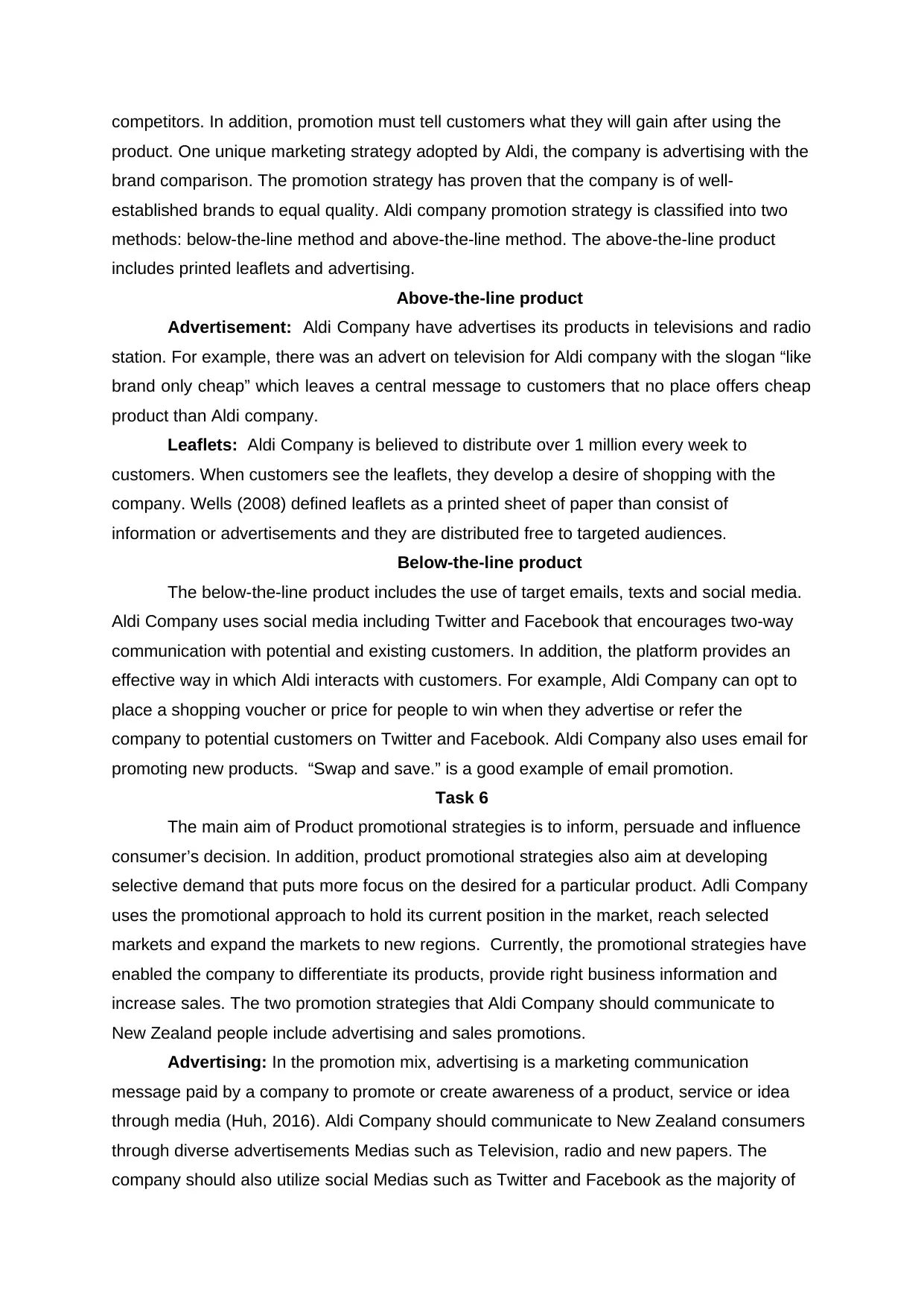
competitors. In addition, promotion must tell customers what they will gain after using the
product. One unique marketing strategy adopted by Aldi, the company is advertising with the
brand comparison. The promotion strategy has proven that the company is of well-
established brands to equal quality. Aldi company promotion strategy is classified into two
methods: below-the-line method and above-the-line method. The above-the-line product
includes printed leaflets and advertising.
Above-the-line product
Advertisement: Aldi Company have advertises its products in televisions and radio
station. For example, there was an advert on television for Aldi company with the slogan “like
brand only cheap” which leaves a central message to customers that no place offers cheap
product than Aldi company.
Leaflets: Aldi Company is believed to distribute over 1 million every week to
customers. When customers see the leaflets, they develop a desire of shopping with the
company. Wells (2008) defined leaflets as a printed sheet of paper than consist of
information or advertisements and they are distributed free to targeted audiences.
Below-the-line product
The below-the-line product includes the use of target emails, texts and social media.
Aldi Company uses social media including Twitter and Facebook that encourages two-way
communication with potential and existing customers. In addition, the platform provides an
effective way in which Aldi interacts with customers. For example, Aldi Company can opt to
place a shopping voucher or price for people to win when they advertise or refer the
company to potential customers on Twitter and Facebook. Aldi Company also uses email for
promoting new products. “Swap and save.” is a good example of email promotion.
Task 6
The main aim of Product promotional strategies is to inform, persuade and influence
consumer’s decision. In addition, product promotional strategies also aim at developing
selective demand that puts more focus on the desired for a particular product. Adli Company
uses the promotional approach to hold its current position in the market, reach selected
markets and expand the markets to new regions. Currently, the promotional strategies have
enabled the company to differentiate its products, provide right business information and
increase sales. The two promotion strategies that Aldi Company should communicate to
New Zealand people include advertising and sales promotions.
Advertising: In the promotion mix, advertising is a marketing communication
message paid by a company to promote or create awareness of a product, service or idea
through media (Huh, 2016). Aldi Company should communicate to New Zealand consumers
through diverse advertisements Medias such as Television, radio and new papers. The
company should also utilize social Medias such as Twitter and Facebook as the majority of
product. One unique marketing strategy adopted by Aldi, the company is advertising with the
brand comparison. The promotion strategy has proven that the company is of well-
established brands to equal quality. Aldi company promotion strategy is classified into two
methods: below-the-line method and above-the-line method. The above-the-line product
includes printed leaflets and advertising.
Above-the-line product
Advertisement: Aldi Company have advertises its products in televisions and radio
station. For example, there was an advert on television for Aldi company with the slogan “like
brand only cheap” which leaves a central message to customers that no place offers cheap
product than Aldi company.
Leaflets: Aldi Company is believed to distribute over 1 million every week to
customers. When customers see the leaflets, they develop a desire of shopping with the
company. Wells (2008) defined leaflets as a printed sheet of paper than consist of
information or advertisements and they are distributed free to targeted audiences.
Below-the-line product
The below-the-line product includes the use of target emails, texts and social media.
Aldi Company uses social media including Twitter and Facebook that encourages two-way
communication with potential and existing customers. In addition, the platform provides an
effective way in which Aldi interacts with customers. For example, Aldi Company can opt to
place a shopping voucher or price for people to win when they advertise or refer the
company to potential customers on Twitter and Facebook. Aldi Company also uses email for
promoting new products. “Swap and save.” is a good example of email promotion.
Task 6
The main aim of Product promotional strategies is to inform, persuade and influence
consumer’s decision. In addition, product promotional strategies also aim at developing
selective demand that puts more focus on the desired for a particular product. Adli Company
uses the promotional approach to hold its current position in the market, reach selected
markets and expand the markets to new regions. Currently, the promotional strategies have
enabled the company to differentiate its products, provide right business information and
increase sales. The two promotion strategies that Aldi Company should communicate to
New Zealand people include advertising and sales promotions.
Advertising: In the promotion mix, advertising is a marketing communication
message paid by a company to promote or create awareness of a product, service or idea
through media (Huh, 2016). Aldi Company should communicate to New Zealand consumers
through diverse advertisements Medias such as Television, radio and new papers. The
company should also utilize social Medias such as Twitter and Facebook as the majority of
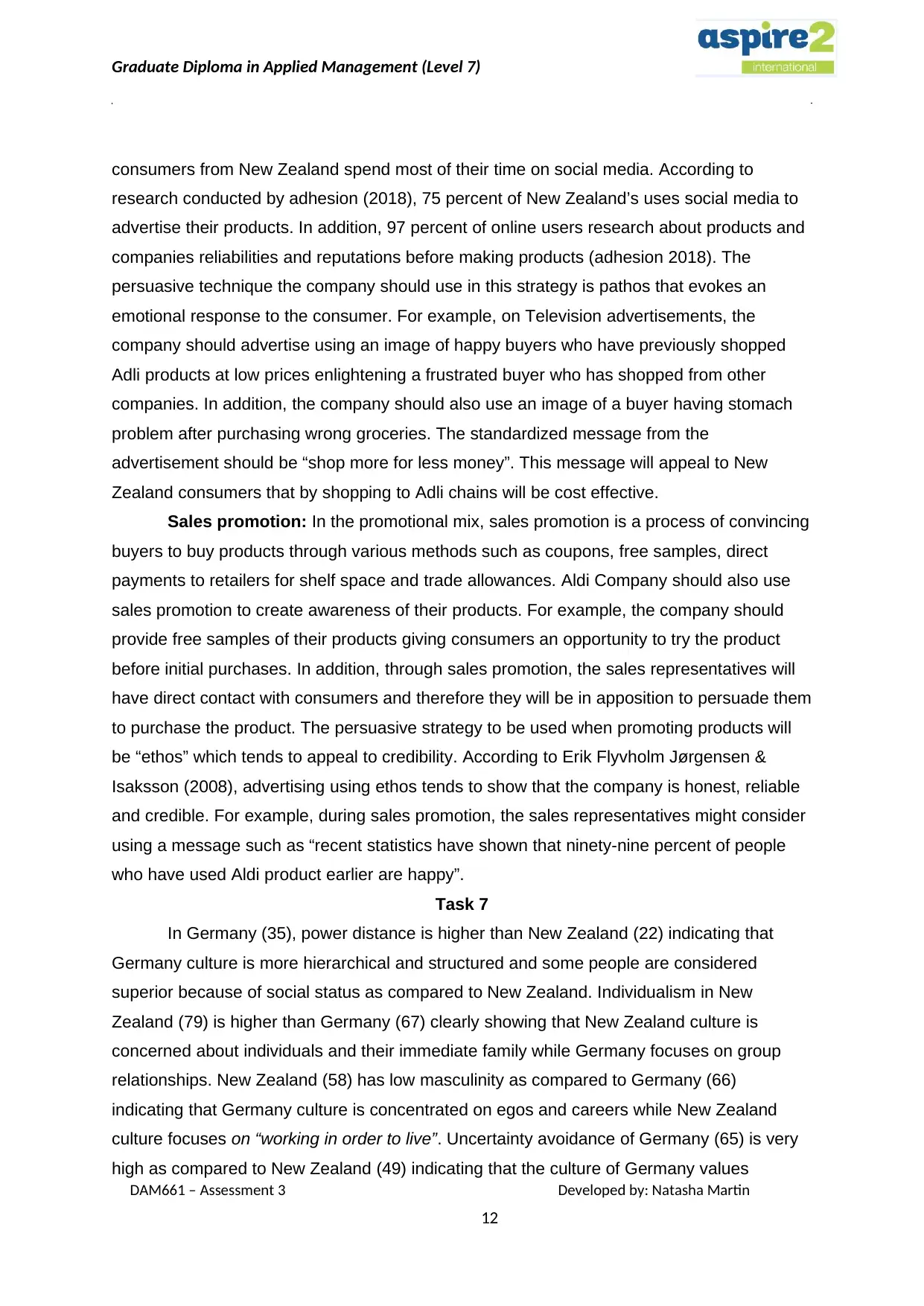
Graduate Diploma in Applied Management (Level 7)
consumers from New Zealand spend most of their time on social media. According to
research conducted by adhesion (2018), 75 percent of New Zealand’s uses social media to
advertise their products. In addition, 97 percent of online users research about products and
companies reliabilities and reputations before making products (adhesion 2018). The
persuasive technique the company should use in this strategy is pathos that evokes an
emotional response to the consumer. For example, on Television advertisements, the
company should advertise using an image of happy buyers who have previously shopped
Adli products at low prices enlightening a frustrated buyer who has shopped from other
companies. In addition, the company should also use an image of a buyer having stomach
problem after purchasing wrong groceries. The standardized message from the
advertisement should be “shop more for less money”. This message will appeal to New
Zealand consumers that by shopping to Adli chains will be cost effective.
Sales promotion: In the promotional mix, sales promotion is a process of convincing
buyers to buy products through various methods such as coupons, free samples, direct
payments to retailers for shelf space and trade allowances. Aldi Company should also use
sales promotion to create awareness of their products. For example, the company should
provide free samples of their products giving consumers an opportunity to try the product
before initial purchases. In addition, through sales promotion, the sales representatives will
have direct contact with consumers and therefore they will be in apposition to persuade them
to purchase the product. The persuasive strategy to be used when promoting products will
be “ethos” which tends to appeal to credibility. According to Erik Flyvholm Jørgensen &
Isaksson (2008), advertising using ethos tends to show that the company is honest, reliable
and credible. For example, during sales promotion, the sales representatives might consider
using a message such as “recent statistics have shown that ninety-nine percent of people
who have used Aldi product earlier are happy”.
Task 7
In Germany (35), power distance is higher than New Zealand (22) indicating that
Germany culture is more hierarchical and structured and some people are considered
superior because of social status as compared to New Zealand. Individualism in New
Zealand (79) is higher than Germany (67) clearly showing that New Zealand culture is
concerned about individuals and their immediate family while Germany focuses on group
relationships. New Zealand (58) has low masculinity as compared to Germany (66)
indicating that Germany culture is concentrated on egos and careers while New Zealand
culture focuses on “working in order to live”. Uncertainty avoidance of Germany (65) is very
high as compared to New Zealand (49) indicating that the culture of Germany values
DAM661 – Assessment 3 Developed by: Natasha Martin
12
consumers from New Zealand spend most of their time on social media. According to
research conducted by adhesion (2018), 75 percent of New Zealand’s uses social media to
advertise their products. In addition, 97 percent of online users research about products and
companies reliabilities and reputations before making products (adhesion 2018). The
persuasive technique the company should use in this strategy is pathos that evokes an
emotional response to the consumer. For example, on Television advertisements, the
company should advertise using an image of happy buyers who have previously shopped
Adli products at low prices enlightening a frustrated buyer who has shopped from other
companies. In addition, the company should also use an image of a buyer having stomach
problem after purchasing wrong groceries. The standardized message from the
advertisement should be “shop more for less money”. This message will appeal to New
Zealand consumers that by shopping to Adli chains will be cost effective.
Sales promotion: In the promotional mix, sales promotion is a process of convincing
buyers to buy products through various methods such as coupons, free samples, direct
payments to retailers for shelf space and trade allowances. Aldi Company should also use
sales promotion to create awareness of their products. For example, the company should
provide free samples of their products giving consumers an opportunity to try the product
before initial purchases. In addition, through sales promotion, the sales representatives will
have direct contact with consumers and therefore they will be in apposition to persuade them
to purchase the product. The persuasive strategy to be used when promoting products will
be “ethos” which tends to appeal to credibility. According to Erik Flyvholm Jørgensen &
Isaksson (2008), advertising using ethos tends to show that the company is honest, reliable
and credible. For example, during sales promotion, the sales representatives might consider
using a message such as “recent statistics have shown that ninety-nine percent of people
who have used Aldi product earlier are happy”.
Task 7
In Germany (35), power distance is higher than New Zealand (22) indicating that
Germany culture is more hierarchical and structured and some people are considered
superior because of social status as compared to New Zealand. Individualism in New
Zealand (79) is higher than Germany (67) clearly showing that New Zealand culture is
concerned about individuals and their immediate family while Germany focuses on group
relationships. New Zealand (58) has low masculinity as compared to Germany (66)
indicating that Germany culture is concentrated on egos and careers while New Zealand
culture focuses on “working in order to live”. Uncertainty avoidance of Germany (65) is very
high as compared to New Zealand (49) indicating that the culture of Germany values
DAM661 – Assessment 3 Developed by: Natasha Martin
12
⊘ This is a preview!⊘
Do you want full access?
Subscribe today to unlock all pages.

Trusted by 1+ million students worldwide
1 out of 15
Related Documents
Your All-in-One AI-Powered Toolkit for Academic Success.
+13062052269
info@desklib.com
Available 24*7 on WhatsApp / Email
![[object Object]](/_next/static/media/star-bottom.7253800d.svg)
Unlock your academic potential
Copyright © 2020–2025 A2Z Services. All Rights Reserved. Developed and managed by ZUCOL.





